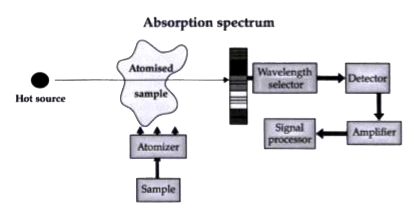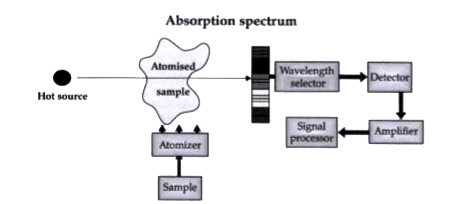What must be the relative velocity of a source and an aboserber consisting of freeIr191 nuclei to observe the maximum absorption of gamma quanta with energy ε=129keV?
For maximum (resonant) absorption, the absorbing nucleus must be moving with enough speed to cancel the momentum of the oncoming photon and have just right enrgy (ε=129keV) availiable for transition to excited state

Since δEγ˜−ε22Mc2 and momentum of the photon is εc, these condition can be satisfied if the velocity of the nucleus is
εMc=cεMc2=218m/s=0.218km/s
Topper's Solved these Questions
- ATOMIC AND NUCLEAR PHYSICSBOOK - IE IRODOV, LA SENA & SS KROTOVCHAPTER - ATOMIC AND NUCLEAR PHYSICSEXERCISE - Nuclear Reaction
42 Videos
- ATOMIC AND NUCLEAR PHYSICSBOOK - IE IRODOV, LA SENA & SS KROTOVCHAPTER - ATOMIC AND NUCLEAR PHYSICSEXERCISE - Elementary Particles
20 Videos
- ATOMIC AND NUCLEAR PHYSICSBOOK - IE IRODOV, LA SENA & SS KROTOVCHAPTER - ATOMIC AND NUCLEAR PHYSICSEXERCISE - Molecules And Crystals
48 Videos
- DIRECT CURRENTBOOK - IE IRODOV, LA SENA & SS KROTOVCHAPTER - DIRECT CURRENTEXERCISE - All Questions
15 Videos
Similar Questions
What should be the relative speed of approach of a source and an absorber consisting of free iron atoms for the resonance absorption of gamma-rays to take place? The energy of the photon is specified in the previous problem.
View SolutionA sourse of gamma quanta is placed at a height h=20m above an absorber. With what velocity should the source be displaced upward to counterbalance completely the gravitational variation of gamma quanta energy due to the Earth's gravity at the point where the absorber is located?
View Solution
Knowledge Check
Read the following text and answer the following questions on the basis of the same:
Atomic Absorption Spectrometer: The atomic absorption (AA) spectrometer is used to analyze metals at very low concentrations, typically in the parts per million (ppm) or parts per billion (ppb) ranges. A liquid sample containing dissolved material whose concentration is to be measured is aspirated into a thin, wide AA flame, or is introduced into a small carbon furnace which is heated to a high temperature.

Basic Principle of AAS is the measurement of absorption of radiation by free atoms. The total amount of absorption depends on the number of free atoms present and the degreee to which the free atoms absorb the radiation. At the high temperature of the AA flame, the sample is broken down into atoms using an atomizer and it is the concentration of these atoms that is measured. Sample in the form of solution is used. It is broken up into a fine mist with the help of an atomizer. When the mist reaches the flame, the intense heat breaks up the sample into its individual atoms. When a photon coming out from the hot source hits an atom and the energy of the photon is equal to the gap between two electron energy levels of the atom, then the electron in the lower energy level absorb the photon and jumps up to the higher energy level. If the photon energy does not correspond to the difference between two energy levels, then the photon will not be absorbed (it may be scattered away). Hence in the spectrum, the wavelength corresponding to the absorbed photons is observed as black lines as shown in the following spectrum of Hydrogen. The dark lines correspon to the frequencies of light those have been absorbed by the sample element. Using this process, a source of photons (generally a white light) of various energies is used to obtain the absorption spectra of different materials and to identify them.
What is the basic principle of Atomic Absorption Spectrophotometer?AEmission of photons when excited electron of an atom comes back to lower energy level.BAbsorption of photons when electrons at lower energy level jumps to a higher energy level.CEmission of electrons from an atom at a very high temperature.DEmission of electron when energetic photons bombard an atom.Read the following text and answer the following questions on the basis of the same:
Atomic Absorption Spectrometer: The atomic absorption (AA) spectrometer is used to analyze metals at very low concentrations, typically in the parts per million (ppm) or parts per billion (ppb) ranges. A liquid sample containing dissolved material whose concentration is to be measured is aspirated into a thin, wide AA flame, or is introduced into a small carbon furnace which is heated to a high temperature.

Basic Principle of AAS is the measurement of absorption of radiation by free atoms. The total amount of absorption depends on the number of free atoms present and the degreee to which the free atoms absorb the radiation. At the high temperature of the AA flame, the sample is broken down into atoms using an atomizer and it is the concentration of these atoms that is measured. Sample in the form of solution is used. It is broken up into a fine mist with the help of an atomizer. When the mist reaches the flame, the intense heat breaks up the sample into its individual atoms. When a photon coming out from the hot source hits an atom and the energy of the photon is equal to the gap between two electron energy levels of the atom, then the electron in the lower energy level absorb the photon and jumps up to the higher energy level. If the photon energy does not correspond to the difference between two energy levels, then the photon will not be absorbed (it may be scattered away). Hence in the spectrum, the wavelength corresponding to the absorbed photons is observed as black lines as shown in the following spectrum of Hydrogen. The dark lines correspon to the frequencies of light those have been absorbed by the sample element. Using this process, a source of photons (generally a white light) of various energies is used to obtain the absorption spectra of different materials and to identify them.
What should be the concentration of metal for analysis using Atomic Absorption Spectrometer?AVery High concentrationBVery low concentrationCMedium concentrationDAny concentrationRead the following text and answer the following questions on the basis of the same:
Atomic Absorption Spectrometer: The atomic absorption (AA) spectrometer is used to analyze metals at very low concentrations, typically in the parts per million (ppm) or parts per billion (ppb) ranges. A liquid sample containing dissolved material whose concentration is to be measured is aspirated into a thin, wide AA flame, or is introduced into a small carbon furnace which is heated to a high temperature.

Basic Principle of AAS is the measurement of absorption of radiation by free atoms. The total amount of absorption depends on the number of free atoms present and the degreee to which the free atoms absorb the radiation. At the high temperature of the AA flame, the sample is broken down into atoms using an atomizer and it is the concentration of these atoms that is measured. Sample in the form of solution is used. It is broken up into a fine mist with the help of an atomizer. When the mist reaches the flame, the intense heat breaks up the sample into its individual atoms. When a photon coming out from the hot source hits an atom and the energy of the photon is equal to the gap between two electron energy levels of the atom, then the electron in the lower energy level absorb the photon and jumps up to the higher energy level. If the photon energy does not correspond to the difference between two energy levels, then the photon will not be absorbed (it may be scattered away). Hence in the spectrum, the wavelength corresponding to the absorbed photons is observed as black lines as shown in the following spectrum of Hydrogen. The dark lines correspon to the frequencies of light those have been absorbed by the sample element. Using this process, a source of photons (generally a white light) of various energies is used to obtain the absorption spectra of different materials and to identify them.
What happens when a photon hits an atom and the energy of the photon is not equal to the gap between two electron energy levels of the atom?AThe photon is absorbed and the electron moves to an intermediate energy level.BThe photon is absorbed and the electron gets scatteredCThe photon is not absorbed. It gets scattered.DNone of the above
What is the minimum height to which a gamma quanta source containing excited Zn67 nuclei has to be raised for the gravitational displacement of the Mossbauer line to exceed the line width itself, when registered on the Earth's surface? The registered gamma quanta are known to have an energy ε=93keV and appear on transition of Zn67 nuclei to the ground state, and the mean lifetime of the exited state is τ=14μs.
View SolutionA free sationary Ir191 nucleus with excitation energy E=129keV passes to the ground state, emitting a gamma quantum. Calculate the fractional change of gamma quanta energy due to recoil of the nucleus.
View SolutionPassing down to the ground state, excited Ag109 nuclei emit either gamma quanta with energy 87keVorK conversion electrons whose binding enrgy is 26keV. Find the velocity of these electrons.
View Solution
